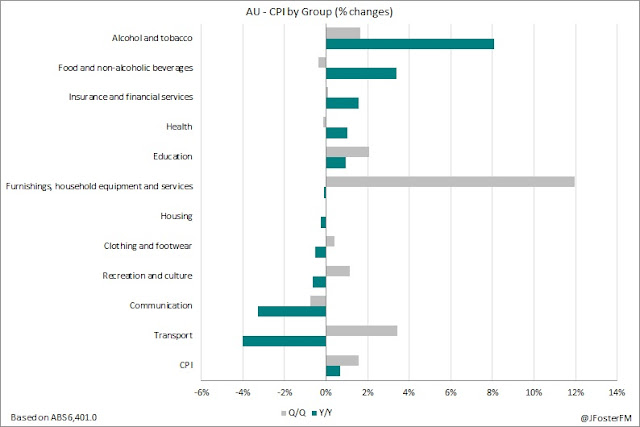Australia's Consumer Price Index (CPI) rebounded as expected in the September quarter rising by 1.6% as the Federal Government's decision to provide free childcare services during the shutdown came to an end and petrol prices lifted. Annual CPI lifted off a 23-year low of -0.3% to 0.7%.
Consumer Price Index — Q3 | By the numbers- Headline CPI lifted by 1.6% in the September quarter to come in a touch above the median estimate of 1.5%. In Q2, CPI posted its largest quarterly fall on record of 1.9%. In annual terms, CPI lifted from its 23-year low of -0.3% to 0.7%.
- Details for the underlying measures (which are seasonally adjusted);
- Trimmed mean lifted 0.41% (expected: 0.4%, prior rev: -0.14%), leaving the annual pace essentially unchanged at 1.19%.
- Weighted median firmed by 0.33% (expected: 0.3%, prior rev 0.07%) as the pace through the year held at 1.27%.
Consumer Price Index — Q3 | The details
Coming after the sharpest quarterly fall on record (-1.9%) in the June quarter reflecting the impact of the Federal Government's free childcare policy during the shutdown and much lower petrol prices, headline inflation rebounded in Q3 as these effects were largely reversed. Free childcare services (outside of Victoria) ended on July 12 while the reopening of economies worldwide during the quarter led to increased demand for oil lifting petrol prices.
In terms of the contributions to the quarterly CPI outcome of 1.6%, the leading group was the furnishings, household equipment and services (1.06ppt) of which childcare accounted for almost all of this increase adding 0.95ppt. The transport group added 0.38ppt to headline CPI, led by a 0.31ppt contribution from automotive fuel. Alcohol and tobacco remained a source of inflation (0.16ppt), while the recreation and culture group (0.16ppt) — a figure largely propped up by imputed contributions from both essentially unavailable domestic and international travel services due to border closures — was supported by strong demand for home entertainment equipment. Meanwhile, the end of free childcare also had an impact on the education group (0.11ppt) as out of pocket costs for families for outside school hours care services returned.
The next chart provides the percentage price changes across each of the groups for the September quarter and in annual terms. Furnishings, household equipment and services increased by almost 12% in Q3 on a statistically spectacular 1,382% rise in childcare costs (they fell 95% in Q2), albeit this still leaves them 26.3% lower than in March, and stronger household goods prices (furniture 6.4%q/q and major appliances 5.3%q/q). Meanwhile, the 2.1% rise in the education group was driven by an 11.1% lift in fees for outside school hours care. Transport costs were up 3.4% in the quarter as petrol prices advanced by 9.4% and new vehicles by 2.5%. The key housing group was flat in Q3 due to the impact of state government initiatives to lower utilities costs (-1.1%) and introduce mechanisms allowing impacted tenants to negotiate reductions to rents (-0.2%). Meanwhile the Federal Government's HomeBuilder scheme helped to restrict new dwelling costs to just a 0.5% rise. Over the past year, alcohol and tobacco (8.1%) and food and non-alcoholic beverages (3.4%) have seen the strongest price rises of all the groups.
An interesting theme that has emerged out of the pandemic is the uneven nature of its impact on inflation. The services sector has been hardest hit by the restrictions and as a result inflation has weakned sharply over the past two quarters such that it is now lower through the year (-0.2%), while at the same time raising demand for goods (household appliances, home entertainment etc) has seen inflation move higher to 3.1%Y/Y from 2.7% pre-pandemic.
Consumer Price Index — Q3 | Insights
Amid the effects of the pandemic, it is difficult to get a clear read on the inflation dynamics occurring in the economy from the CPI data alone due to measurement issues as discussed by the ABS here. The weak pace in underlying inflation (that removes the volatile price changes) however is a key factor driving expectations for the RBA to ease its policy stance at next week's meeting.






